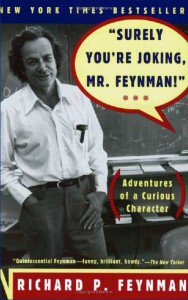 Richard Feynman was America’s best-known theoretical physicist, a Nobel laureate and, according to a 1999 poll of 100 of the world’s most highly esteemed scientists, one of the ten greatest physicists to ever live. It is difficult to comprehend intellect on that scale, and part of the joy of this book, for me, was in attempting to gain some insight into his mind. By the time he was ten years old, he had built a make-shift laboratory in his home and began experimenting with electrical currents and radios, becoming so proficient that the small town he grew up in knew to contract him to repair broken radios rather than the more experienced, more costly repairmen. By the time he was fifteen years old, he had taught himself trigonometry, advanced algebra, analytic geometry and both differential and integral calculus. In his final year of high school, he won the New York University Match Championship, besting his nearest competitors by so wide a margin that the judges of the competition were left shocked. Before he could complete his graduate studies in physics at Princeton, he was tasked with giving lectures on particle physics to the likes of Albert Einstein and sent to Los Alamos to work on the Manhattan Project. In the years since his death in 1988, (from abdominal cancer), Feynman has developed something of a cult following, and this book, a collection of audio recordings, lectures and interviews forming something like a memoir, has been the driving force behind his popularity. The book reveals a brilliant mind playfully interacting with the outside world, infinitely curious, shockingly naive and endeavoring constantly to keep itself amused.
Richard Feynman was America’s best-known theoretical physicist, a Nobel laureate and, according to a 1999 poll of 100 of the world’s most highly esteemed scientists, one of the ten greatest physicists to ever live. It is difficult to comprehend intellect on that scale, and part of the joy of this book, for me, was in attempting to gain some insight into his mind. By the time he was ten years old, he had built a make-shift laboratory in his home and began experimenting with electrical currents and radios, becoming so proficient that the small town he grew up in knew to contract him to repair broken radios rather than the more experienced, more costly repairmen. By the time he was fifteen years old, he had taught himself trigonometry, advanced algebra, analytic geometry and both differential and integral calculus. In his final year of high school, he won the New York University Match Championship, besting his nearest competitors by so wide a margin that the judges of the competition were left shocked. Before he could complete his graduate studies in physics at Princeton, he was tasked with giving lectures on particle physics to the likes of Albert Einstein and sent to Los Alamos to work on the Manhattan Project. In the years since his death in 1988, (from abdominal cancer), Feynman has developed something of a cult following, and this book, a collection of audio recordings, lectures and interviews forming something like a memoir, has been the driving force behind his popularity. The book reveals a brilliant mind playfully interacting with the outside world, infinitely curious, shockingly naive and endeavoring constantly to keep itself amused.
I was particularly enamored of the chapters discussing his attempts to learn Portuguese and Japanese, and his corresponding stays in Brazil and Japan, with the former culminating in him joining a samba band and competing in local festivals. Or his brief dalliance with drawing and painting, resulting in him exhibiting his works in local pubs and brothels. He describes attending an interdisciplinary conference between the sciences and humanities (of which he was the only representative for science), the first and last that he would attend, and the stenographer for the conference approaching him at its conclusion, puzzled by his attendance because, unlike those luminaries of social theory, she could understand what he had to say.
The book concludes with a wonderfully important essay on the distinction between bad and good science (what Feynman calls “cargo cult science”). The latter is the picture of humility and diligence, checking and rechecking equations, asking questions, skeptical of results, especially those that flatter the theories and ideas of the scientist. The former begins with the end in mind and is easily persuaded by flimsy-yet-flattering evidence. It was this essay that produced his oft-quoted maxim: “The first principle is that you must not fool yourself – and you are the easiest person to fool.” And it was this essay that gave birth to my other favorite quotation of his: “Reality must take precedence over public relations, for nature cannot be fooled.” I find it striking (but not surprising) that while both those phrases are directed at scientists, they are equally applicable to writers.